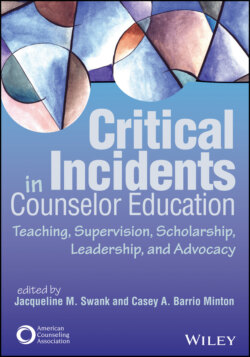Читать книгу Critical Incidents in Counselor Education - Группа авторов - Страница 35
Case Analysis and Discussion
Оглавление“Plagiarism occurs when a student intentionally or unintentionally uses another person’s words or ideas without properly crediting their source, an offense that most university officials consider to be a serious breach of appropriate academic conduct” (Youmans, 2011, p. 749). Plagiarism is common among students. In a review of the literature, Youmans (2011) found that 7% to 55% of college students had knowingly plagiarized. Universities recognize the slippery slope of academic dishonesty during students’ careers, noting that academic dishonesty can hinder the completion of degrees and contributions to potential fields of work (Youmans, 2011).
The ACA Code of Ethics (American Counseling Association [ACA], 2014) makes it clear that counselor educators need to be well informed in the areas they teach (Standards F.7.a., F.7.b.). Many students and faculty members are drawn to certain authors, sometimes networking with them while attending conferences and programming. This is why Professor P easily realized that the student had submitted a work that was not their own. Counselor educators and supervisors also have an ethical responsibility to ensure aspiring counselors have the academic skills and professional dispositions to be in the field (Standards F.6.b., F.9.a.). This includes remediating incidents of academic dishonesty, which is a reflection of students’ work and their moral character. Even when reproducing language from their own published works, authors need to properly cite and quote (Standards G.5.b., G.5.c.).
Vehviläinen et al. (2018) discussed how faculty members who work with students who have plagiarized can use one of two approaches: a rules ethical approach or a care ethical approach. The rules ethical approach is “based on the notion of the universal application of a rule viewed as detached from the subject” (p. 2), whereas the care ethical approach “places the act in relation to the actor’s intentions and understandings” (p. 2). In deciding how to work with this student, Professor P was torn between being student forward or rule forward. As a counselor educator who was largely person centered, Professor P leaned toward a care ethical approach. Instead of sending the case to a disciplinary committee, Professor P created a lesson on the ins and outs of plagiarism and strategies for avoiding plagiarism. In accordance with a rules ethical approach, Professor P gave the student a failing grade for the assignment. However, they did not report the incident to the administration.
This decision to use a care ethical approach in assessing the student’s explanation for why they had plagiarized the assignment but a rules ethical approach in handling grading was in line with a student-centered approach to teaching. It is important for instructors to be mindful of student diversity and needs (ACA, 2014, Standards F.11.b., F.11.c.). In this case, Professor P was mindful of this student’s socioeconomic and age diversity. The student was older than their peers and admitted they were struggling with this type of writing and unfamiliarity with plagiarism. The student also appeared to have a technology gap compared to students who had moved directly through their undergraduate program and into their graduate program in a time of very easy access to journal articles, books, and websites (Burt et al., 2011). This increased the chance that the peers had been formally educated about plagiarism in a way this student had not. Although their peers may have been accustomed to plagiarism-checker reports, the entirety of this student’s prior work may have been graded by hand, thus limiting the student’s learning opportunities in comparison to peers who had access to this technology, which was normalized in their work.
